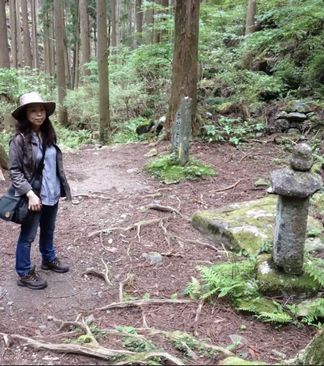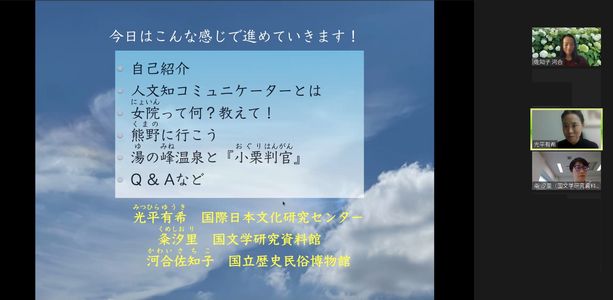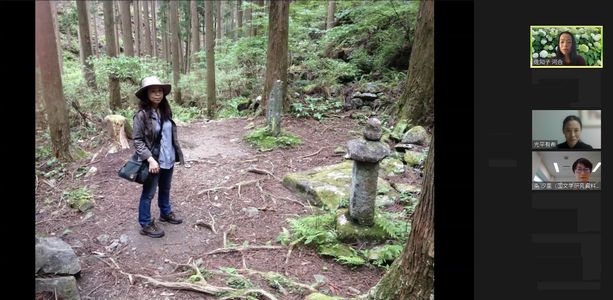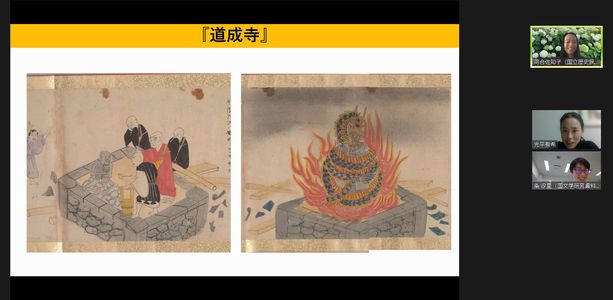Liberal Arts Communicators Live! First Report : "A Conversation about Nyoin and Oguri Hangan"

* Our title in Japanese is “jinbunchi (人文知)” communicator. We, the communicators, strive to carry out our activities and execute our duties with the following understanding. Jinbunchi refers to knowledge, experience, and culture accumulated among humans, which is not limited to the humanities fields per se. Our important mission is to connect society and specialists across diverse fields beyond Japan’s national borders.
1. Introduction
At the Inter-University Research Institute Symposium held on October 24, 2021, we organized a live online webcast, the project emerged out of the idea of having the liberal arts communicators, who serve as ambassadors connecting society and researchers across fields encompassing human knowledge, experience, and culture (jinbunchi), develop a cross-disciplinary discussion from the perspective of their respective fields of expertise. Through such an attempt, they convey the appeal of jinbunchi and the joys of research to society. In this installment, Dr. Sachiko Kawai, a researcher at the National Museum of Japanese History, and Dr. Shiori Kume, a researcher at the National Institute of Japanese Literature, report on a dialogue entitled, “A Conversation about Nyoin and Oguri Hangan: Let’s Visit Kumano with Liberal Arts Communicators!”
Dr. Kume and Dr. Kawai explored the appeal of Kumano Sanzan, a World Heritage Site and one of Japan’s most celebrated sacred mountain landscapes, while drawing connections to their own research themes of nyoin (see the explanation below) and the legendary male protagonist, Oguri Hangan. After the talk, the facilitator, Dr. Yuki Mitsuhira (International Research Center for Japanese Studies), joined the two presenters to moderate an exchange of views with members of the audience while touching on the allure of their respective fields of research and the unexpected connections between them.

Screenshot 1 from the live webcast
The agenda explained by Dr. Mitsuhira
2. Who Are Nyoin? Their Role and Importance
Dr. Kawai, whose research focuses on nyoin (女院), gave a talk entitled “Nyoin and Their Powers Gained from Medieval Landholdings.” The nyoin institution has a long history lasting for hundreds of years, from the appearance of the first nyoin, Higashisanjō-in (962-1001) in 991 CE, until it was abolished in the Meiji period (1868-1912). The earliest nyoin were retired queen-consorts who had also given birth to a sovereign, but by the late eleventh century, such rules were relaxed. Royal consorts who were not sovereigns’ biological mothers began receiving a nyoin title, and even unmarried royal daughters started becoming nyoin.
While the period from the late 11th to early 13th centuries is often called “the insei period” or “the era of (male) retired sovereigns’ governance,” their female equivalents, nyoin, also wielded political influence as royal mothers and daughters supported young sovereigns. Moreover, medieval nyoin owned numerous landed estates (shōen) across the Japanese archipelago and used them to play important roles. For example, they supported royal and aristocratic families’ offspring as adoptive mothers and sponsored memorial services for their deceased family members. Despite the importance of nyoin in Japanese history, however, high school textbooks in Japan rarely introduce the definition of nyoin or their roles. This suggests a gender issue in history education. Dr. Kawai’s talk highlights how such gender disparity is a serious problem affecting our way of seeing current and future generations of Japanese women, as well as their own attitudes toward how they should live in society.
Although medieval nyoin were large estate proprietors, the way they actually acquired power was quite complex. To understand their power wielding mechanism, it is crucial to analyze a gap between authority (socio-politically acknowledged rights) and power (the ability to get things done or influence). In her talk, through the case study of Sen’yōmon-in (1181–1252), Dr. Kawai illustrated how nyoin coped with challenges by devising strategies even while suffering failures.
Additionally, in medieval Japan, the Kumano pilgrimage was conducted by taking the trail known as the Nakahechi, which traverses the mountainous routes of the Kii Peninsula. Nyoin also undertook this pilgrimage. Although they rode on a palanquin, they occasionally walked as well. In one case, Shumeimon-in (1182-1264), the queen-consort of Sovereign Gotoba, was stranded on her journey when heavy rains caused the river to flood. Here, Dr. Kawai suggests that the people of that time might have considered that traveling to Kumano on their own, even at great risk, would bring them merit.

Screenshot 2 from the live webcast
Dr. Kawai during her Kumano pilgrimage, walking through the route Nakahechi
(At the remains of one of the subsidiary shrines, Ōsakamoto ōji)
3. The Kumano Tradition of the Hot Spring that Brought Oguri Back to Life
The talk by Dr. Kume, a scholar specializing in sekkyō-bushi (説教節), or “sermon ballads,” which were a form of narrative performance art from the end of the Muromachi period (1392-1568) until the beginning of the Edo period (1603-1867), focused on one of the representative works of this genre, the tale of Oguri Hangan. This ballad tells the story of Oguri Hangan, a child born in answer to a prayer to the deity Bishamonten in Kurama, from his birth to his death. Oguri ignores his parents’ recommended marriage partners and has a liaison with an enormous serpent. As a result, he is disowned by his parents and sent into exile, where he forms a romantic connection with Terutehime, the female protagonist of the story. However, when Oguri is poisoned by Terutehime’s father for imposing himself as a bridegroom without his father-in-law’s consent, he is sent to Hell to face the judgment of Enma, the king of the underworld. At the appeal of his loyal retainers, he is returned to life, but his resurrected form remains that of a hungry ghost. To return to his human appearance, he is pulled by Holy Men (shōnin) of Fujisawa on a flatbed cart to the Yunomine hot spring in Kumano, where he safely regains his original form and is reunited with his beloved Terutehime. The hot spring that revived Oguri is still used today at the Yunomine Onsen and known as Tsuboyu., which is located near Kumano Hongū, one of the three major shrines in Kumano.
As to why Oguri was brought back to life and why this had to take place at the Yunomine hot spring in Kumano, Dr. Kume discussed the characteristics of the place that attracted the story, citing reasons such as the Oguri Hangan tradition being handed down by the head temple of the Ji-shū branch of Pure Land Buddhism in Fujisawa, Kanagawa, the tale of the monk Ippen Shōnin’s ascetic practices after receiving a message from the Kumano Gongen deities, and the fact that Kumano was a sacred site associated with resurrection.

Screenshot 3 from the live webcast
Dr. Kume explaining the legend of Anchin and Kiyohime at Dōjōji, a Buddhist temple in Wakayama Prefecture, with the picture scrolls
Dōjōji ryakuengi (the Brief Record of Dōjōji’s Legends and History)
owned by the National Institute of Japanese Literature
Source:https://kotenseki.nijl.ac.jp/biblio/200013419/viewer/1
4. Conclusion
When the floor was opened to members of the audience, a wide variety of questions were asked about the talks on subjects ranging from “entertainment for tourists based on the Oguri legend,” “succession and inheritance from (male) sovereigns to their daughters,” “the rights of husbands and brothers in comparison to that of their female family members,” and “the gender and power of subordinates.” Then, Dr. Kawai and Dr. Kume addressed these questions with specific examples, and the talk concluded with an interactive exchange of views about other miracle tales set in Kumano and hot spring delicacies, with hopes expressed for further research in the future.
Text: Kawai Sachiko, Liberal Arts Communicator (National Museum of Japanese History)
Kume Shiori, Liberal Arts Communicator (National Institute of Japanese Literature)
Mitsuhira Yuki, Liberal Arts Communicator (International Research Center for Japanese Studies)
